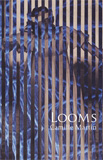Review by CL Bledsoe
Shearsman Books
50 Westons Hill Drive
Emersons Green
Bristol BS16 7DF
United Kingdom
ISBN-13: 978-1848612358
2012, 80 pp., $15.00
www.shearsman.com
In Camille Martin’s fourth full-length collection, she begins with a quote from Barbara Guest: “Its remoteness from the center of things is what is endearing about a Tale and it doesn’t tell the truth about itself; it tells us what it dreams about.” Here, Martin is telling the reader how to approach these poems; they are not, necessarily straightforward ‘hit the reader on the head with blunt meaning’ poems. They are subtle. They sidle up to the truth, to meaning, which makes them all the more interesting to read. There is also the question of the title. “Looms” are used for weaving useful, pleasing tapestries from disparate threads. Likewise, Martin pulls elements of her life, experience, and observations to create these poems, which are beautiful, elegant, and well-wrought.
“Right now is what dwindling feels like,” the untitled first poem begins, establishing an intense tone, “despite/ the mulberry outside my window steadfastly/ anchoring its taproot.” Martin challenges the Romantic idea of nature as an escape from the depredations of society. Here, nature isn’t helping. The poet describes a world growing with knowledge and connections:
The new century counts planets
that might support rooted beings and ravenous predators.
But stardust piles up on lines connecting dots
in constellations, blurring them into nebulae…
I’m reminded of the negative reaction in Whitman’s “When I Heard the Learn’d Astronomer,” in which the narrator leaves behind the scientific talk of this astronomer in order to simply go enjoy the beauty and mystery of the stars. Here, Martin also senses a failing when it comes to attempts to categorize nature and the immensity of space, the stars, etc. She feels no comfort: “Shapeless/ experience waffles between concrete and abstract, accounting/ for the popularity of horoscopes …” Space is simply too big to approach sensibly, for many people, Martin seems to be saying, including herself. Not just space, but nature, perhaps life, itself. She uses words like “abstractly,” “non-existent,” and finally concludes with the closest thing to peace she can achieve, “A more or less concrete cup of coffee balances on my belly,/ wobbling to the diastolic and systolic rhythms of my heart.”
Martin continues with this theme of balancing spirituality and logic in the also untitled next poem: “To believe is to please what most you love.” It’s a profound and difficult idea to unpack, and also to live up to. She continues, referring to “an old ballad/ whose punctuation flickers like fireflies.” It’s not much of a leap to apply this analogy to Martin’s religious beliefs, themselves, especially as she continues: “Meaning/ darkness, believable onyx in which crested memories/ wander into a cascade. Of what? No one recalls.” Again, her imagery implies more of a memory of a memory in regards to religiosity, as opposed to a deep, fervent belief. Her language waivers between specifics and fading generalities, habit and belief. Finally, she pronounces the source of her faith as “A smooth-talking/ carnival barker,” and concludes “any faith will do.” In the end, it’s the comfort that appeals, not the details.
Throughout these poems, Martin explores what it is to be a moral, rational human concerned about the effects and the causes of ones actions. In an untitled poem on page 27, she approaches the difficulty of considered actions:
No one wants to break the storm of habits
the experts claim won’t change anyway.
So we have the satisfaction of being right
and safe, hiding behind our galactic shrine
of choice, fastening bows on silhouettes.
She continues with a call to action: “It’s time/ someone shoved a mountain.” In the doldrums of habit, she explains, “all struggle to recollect/ what storms do.” Again, people forget the beauty and majesty of life when caught up in the enormity of the now. Here, the natural world could be a salvation, but it is ignored and forgotten. As she says, in another poem, “The irony of Autumn is a gilded song.”
Looms is a wonderful continuation of Martin’s previous collection, Sonnets, in which she explored similar themes as well as playing with the sonnet form. Martin has proven herself to be a solid poet with an ear for language and an inquisitive mind delving into the big questions we all face. In this collection, Martin has woven a rich tapestry of poems that are well worth perusing.
__________
CL Bledsoe is the author of the young adult novel Sunlight; three poetry collections, _____(Want/Need), Anthem, and Leap Year; and a short story collection called Naming the Animals. A poetry chapbook, Goodbye to Noise, is available online at www.righthandpointing.com/bledsoe. Another, The Man Who Killed Himself in My Bathroom, is available at http://tenpagespress.wordpress.com/2011/08/01/the-man-who-killed-himself-in-my-bathroom-by-cl-bledsoe/. His story, “Leaving the Garden,” was selected as a Notable Story of 2008 for Story South’s Million Writer’s Award. His story “The Scream” was selected as a Notable Story of 2011. His nonfiction piece “Thesis” was nominated for 2012 Best of the Net. He’s been nominated for the Pushcart Prize five times. Bledsoe lives with his wife and daughter in Maryland, and blogs at Murder Your Darlings. (clbledsoe.blogspot.com)